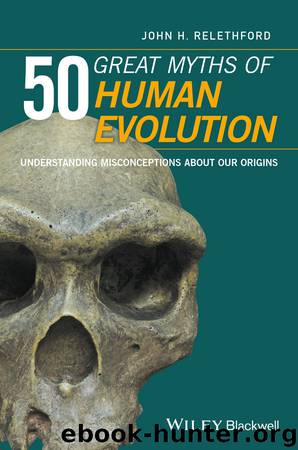50 Great Myths of Human Evolution by John H. Relethford

Author:John H. Relethford
Language: eng
Format: epub
ISBN: 9781119308034
Published: 2017-01-17T00:00:00+00:00
Myth #28 Species with larger brow ridges are more ape‐like
Status: In the nineteenth century, large brow ridges were considered a primitive ape‐like characteristic and the relationship of human fossils to living humans was interpreted in part based on the size of their brow ridges. Evolution of bow ridge size is actually more complex and during the course of the evolution of the genus Homo brow ridges have increased and then decreased in average size over time. A number of models have been proposed to explain the presence of large brow ridges in past species such as Homo erectus. Homo heidelbergensis, and the Neandertals. To date, the best explanation is biomechanical stress.
When students in my paleoanthropology class examine fossil casts of Homo erectus, they are immediately impressed by the size of the brow ridges in some of the specimen. (A particularly impressive specimen is the cast of the OH 9 fossil skull cap from Olduvai Gorge; students often write “Huge!!!” with multiple exclamation points when completing their lab assignments.) My students also see that although most H. erectus specimens in the lab have larger brow ridges than in living humans, there is variation, and many ask why some skulls show smaller or larger brow ridges. The curiosity about brow ridges continues into later labs, as students examine casts of Homo heidelbergensis and Neandertals, noting that they still have impressive brow ridges, although somewhat different in form.
The fascination with brow ridges has long been a part of the general interest in human evolution. As author and anthropologist Mary Doria Russell has noted, the brow ridge was once described by anatomist Hermann Schaafhausen as “a most remarkable peculiarity.”43 People have read many things into the meaning of large brow ridges, both in terms of evolutionary adaptations and in terms of the mental capacities of our ancestors.
The brow ridge is more technically known as the supraorbital torus. A torus is a ridge of bone, and “supra” is Latin for “above,” making the supraorbital torus the ridge of bone above the eye orbits. Brow ridges vary quite a bit among living humans but seldom form the same type of complete torus seen in earlier species,44 and they are much smaller on average than in apes or in most earlier species of Homo. Today, men on average have larger brow ridges than women. In fact, the size of the brow ridge is one of the cranial traits used by forensic anthropologists when determining sex from skeletal remains. There is also variation between populations in brow ridge size. Natives of Australia and Melanesia tend to have rather large brow ridges on average, as do some natives of South America, while people of European ancestry have smaller brow ridges, and people of African and East Asian ancestry even smaller.45
A large brow ridge has often been viewed as a primitive, ape‐like trait. Among living primates, large brow ridges are found in African apes but not in Asian apes, and in only a few monkey species. Brow ridges in apes
Download
This site does not store any files on its server. We only index and link to content provided by other sites. Please contact the content providers to delete copyright contents if any and email us, we'll remove relevant links or contents immediately.
Sapiens: A Brief History of Humankind by Yuval Noah Harari(14168)
Sapiens by Yuval Noah Harari(5266)
Pale Blue Dot by Carl Sagan(4861)
Homo Deus: A Brief History of Tomorrow by Yuval Noah Harari(4779)
Livewired by David Eagleman(3626)
Origin Story: A Big History of Everything by David Christian(3592)
Brief Answers to the Big Questions by Stephen Hawking(3319)
Inferior by Angela Saini(3211)
Origin Story by David Christian(3119)
The Gene: An Intimate History by Siddhartha Mukherjee(3014)
Signature in the Cell: DNA and the Evidence for Intelligent Design by Stephen C. Meyer(2999)
The Evolution of Beauty by Richard O. Prum(2916)
Aliens by Jim Al-Khalili(2766)
How The Mind Works by Steven Pinker(2697)
A Short History of Nearly Everything by Bryson Bill(2582)
Sex at Dawn: The Prehistoric Origins of Modern Sexuality by Ryan Christopher(2443)
From Bacteria to Bach and Back by Daniel C. Dennett(2425)
Endless Forms Most Beautiful by Sean B. Carroll(2403)
Who We Are and How We Got Here by David Reich(2376)
